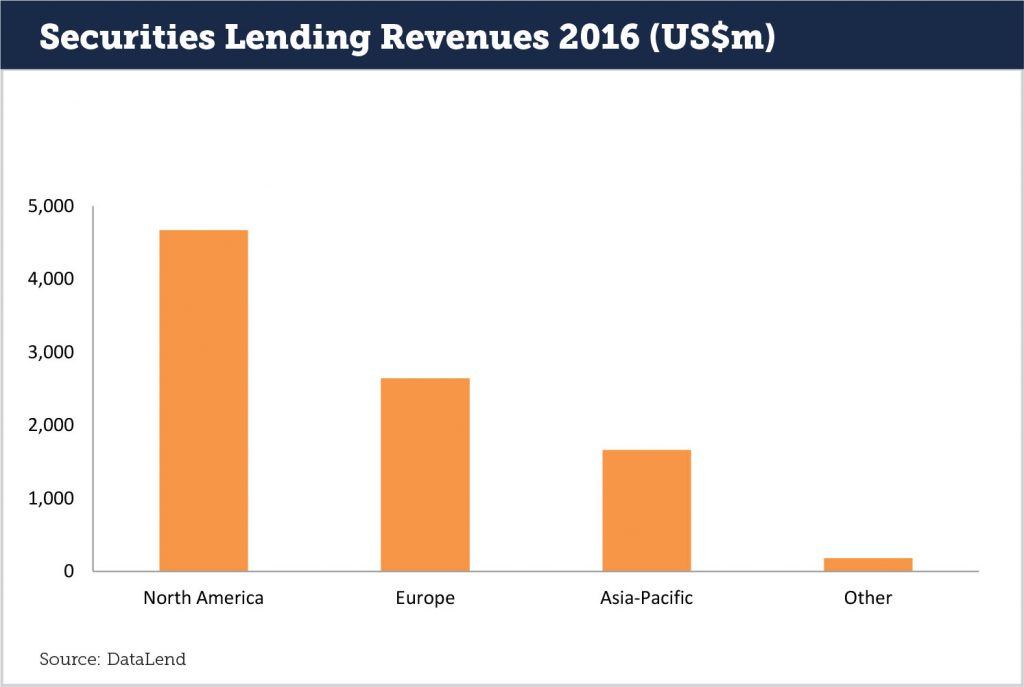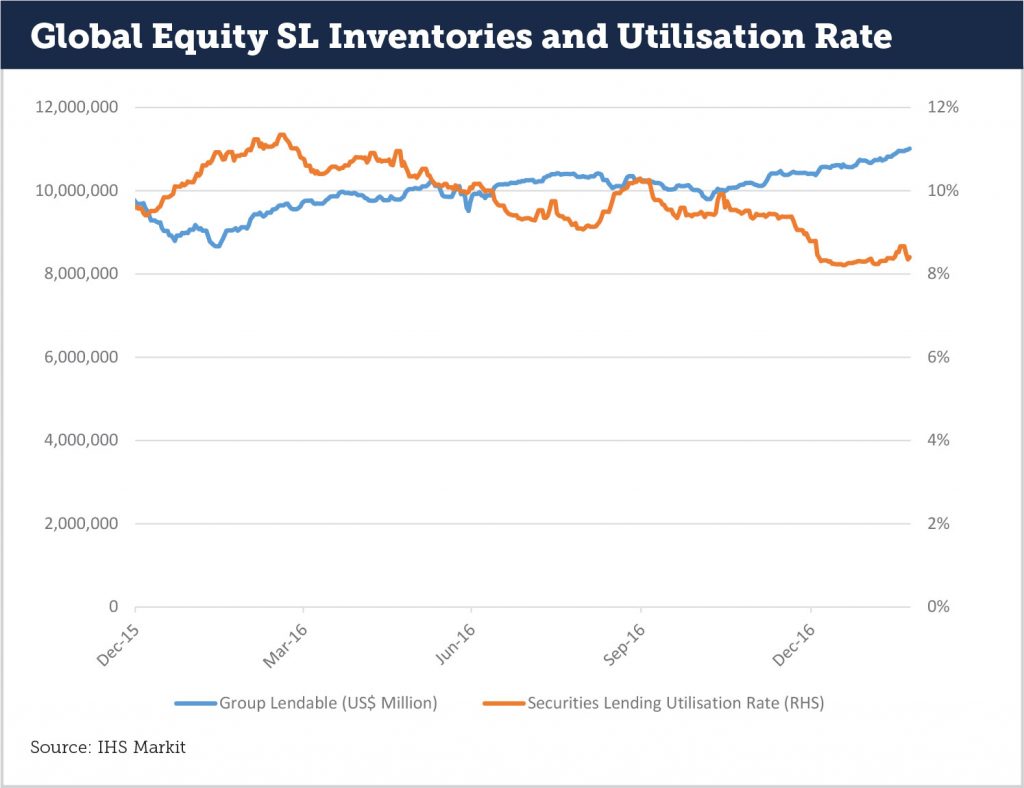Amidst increasing demand from investors to generate extra revenues, the global securities finance industry is steadily moving away from a standard agent lender model and towards a greater diversity of approaches. The trend towards non-traditional securities finance models reflects heavier balance sheet constraints on the bank-owned agent lenders that have traditionally played a central role in the market. As a result, market participants are seeking more capital-efficient ways of conducting securities loans. Meanwhile, actors along the lending and borrowing chain are demanding better and more granular information to inform their decision-making.
Demand to lend meets capacity constraints
Asset owners are increasingly keen to lend their securities. According to IHS Markit, inventories of equities available for loans reached over US$11 trillion in late February 2017, up 21 percent from a year earlier.
“Beneficial owners, whether that be pension funds, sovereign wealth funds, mutual funds or insurance companies, are very keen to identify additional sources of revenue to improve alpha and offset costs, which are rising,” says Paul Wilson, Global Head of Agent Lending Product and Portfolio Advisory at J.P. Morgan.
“There’s a compression of management fees in the asset management business,” notes Simon Colvin, vice president at IHS Markit.
“Even though the inventories of securities available for lending are at an all-time high, the profitability of lending is holding up because revenues are still growing faster than inventories,” Colvin adds.
According to Keith Haberlin, global head of securities lending at Brown Brothers Harriman, a broadening range of funds is now interested in generating incremental returns through lending. Traditionally, low-fee, low-turnover funds like index funds and ETFs have been a major source of the securities available for loans.
“The ongoing shift from active to passive funds is a big tailwind for securities lending, since it’s an integral part of the low-cost asset management model,” says Haberlin.
“In the US ETF market, 85% of ETFs with annual total expense ratios below 0.5% engage in lending. But this is now prompting active equity managers to take a closer look at securities lending as well.”
According to DataLend, global securities lending revenues exceeded US$9 billion during 2016, with over half of the total generated in North America.

But rising willingness to lend does not by itself generate increased demand from borrowers. And there appears to be some sand in the cogs of the market. IHS Markit’s data show a falling securities lending utilisation rate over the last year, with only 8.4 percent of equity inventories being taken up by borrowers in late February 2017, down from over 11 percent a year earlier.

According to Bill Kelly, head of securities finance client relationship management and business development at BNY Mellon, several factors are at play in explaining the slower take-up of loans.
“The securities lending market faces reduced capacity from borrowers, an effect both of new regulations and capital charges on agent lenders, as well as a general trend towards deleveraging,” says Kelly.
For example, under the incoming Basel III capital and liquidity framework for banks, new balance sheet costs are being imposed on agent lenders offering indemnification to beneficial owners. This indemnification covers clients against potential losses from the default of a counterparty in a securities lending trade.
In the past, indemnification was offered to clients at effectively zero cost for the agent lender.
“Historically it’s been a free offer,” says Jeff Kidwell, director and head of direct repo at AVM Solutions.
“Now that many providers are facing increased capital costs for providing indemnification, some of them are interested in passing them along,” adds Kidwell.
Brown Brothers Harriman’s Haberlin notes that indemnification is a historical oddity.
“The practice of indemnification is unique to securities lending. It doesn’t exist in repo, which is economically a similar transaction. But it’s hard to convince beneficial owners to give up something they’re used to,” says Haberlin.
“The rising capital costs of indemnification for bank-owned agent lenders, combined with demands to meet return on capital targets, are a challenge for the whole industry,” he adds. “It’s beginning to play out in terms of differentiated pricing for loans with an indemnity and without.”
“Indemnification requires agents to hold higher levels of capital than before and the costs have gone up significantly over the last 3-4 years,” observes J.P. Morgan’s Paul Wilson.
However, a prime broker servicing the securities borrower community expressed uncertainty regarding the extent to which indemnification costs have been reflected in the prices agent lenders charge for loans.
“It’s unclear to what extent the rising costs of indemnification for agent lenders are being passed on to us as borrowers. From our perspective, there are usually alternative ways of sourcing the same securities, for example by borrowing from non-bank counterparties, by using a synthetic structure like a total return swap or by borrowing an ETF and converting it to the underlying assets,” says Bob Zekraus, director of prime services at Scotiabank.
In January 2017, the G20 Financial Stability Board (FSB) pointed out a regulatory gap in the treatment of securities lending indemnification, observing that, while bank-owned agent lenders are now required to bear balance sheet charges for offering these insurance policies to clients, agent lenders owned by asset managers face no equivalent costs.
In a set of non-binding policy recommendations, the FSB suggested that asset managers may be forced to reinsure the risks created by indemnification, a step that the largest asset manager involved in agent lending, BlackRock, has so far resisted.
In a series of public statements made during the FSB’s consultation process, BlackRock pointed out that it lends securities only from funds managed in-house, rather than competing head-to-head with bank-owned agent lenders. The asset manager also refuted suggestions that its indemnification activities create systemic risk, the main policy concern of the FSB.
Another non-bank agent lender, eSecLending, says that its policy is to source indemnification from third parties.
“We’ve always purchased indemnification insurance from highly rated external insurers. This has been a real and significant cost on our balance sheet,” says Chris Jaynes, president and head of client relationship management and business development at the firm.
Jaynes believes that the trend of increased capital costs for indemnification could play out in different ways for the investor client base.
“From the client’s perspective, the rising costs of indemnification for bank owned agent lenders leave you with three choices. You pay more in fees, you accept scaled-back legal language for the indemnity or you get lower volumes and revenues,” he says.
New lending models—CCPs and P2P
A direct consequence of the heavier capital constraints on the majority of agent lenders is the search for new lending models. This can mean the structuring of trades in a different legal format, the routing of trades via central counterparties (CCPs) or bilateral, peer-to-peer (P2P) securities lending.
“Some of the market is looking at a more capital-efficient way to undertake business,” says J.P. Morgan’s Paul Wilson.
“This includes consideration of using a CCP or use of a pledge structure rather than a title transfer for collateral. The pledge structure is not the norm outside of the U.S. It’s important to recognize that the traditional lending model—a beneficial owner using an agent to lend securities to a borrower, who lends them on to a hedge fund—does contain some excess cost and inefficiencies.”
Jason Strofs, managing director at BlackRock, points out the positive aspects of central counterparties.
“We’re bullish on the future role of securities lending CCPs,” says Strofs. “They provide the most relief under current regulations to the broker/dealers. They also provide benefits for agent lenders, and material pre- and post-trade efficiencies for all participants.”
Scotiabank’s Bob Zekraus quantifies the benefits of the CCP model for a typical securities borrower.
“From a borrower’s perspective, there’s a huge incentive to face off against a qualifying CCP,” says Zekraus.
“Trades via a CCP could potentially carry a risk weight of less than 5%, compared to 20% for a trade with a bank and 100% for a trade with a broker/dealer.”
But some market participants note that, compared to the mandatory clearing of standardised bilateral derivatives, something that regulators pushed for immediately after the financial crisis and put into effect only a few years later, CCPs for securities lending have been slow to arrive.
“Securities lending CCPs are taking a lot longer than expected to go live,” says AVM’s Jeff Kidwell.
“It’s hard to tell whether the regulators are behind the initiatives or not, depending on whether the CCPs are meant to be exclusive of buy-side clients or inclusive of buy-side clients. The CCP plans that just include broker dealers and money market funds don’t seem to have as much traction as the projects that are all-to-all.”
Mirroring developments in the derivatives market, securities lending CCPs are likely to emerge on a regional basis, according to Dave Martocci, global head of agency securities lending at Citi. Meanwhile those routing their future business via CCPs will need to play close attention to legal structures, Martocci points out.
“A single securities lending CCP for the global marketplace is not likely,” says Martocci.
“If the CCP model ever takes off, we’ll probably need three regional hubs for the US, Europe and Asia.”
“There’s still a tremendous way to go. We need a recognisable, true and tested CCP product that is easy to sell to clients. From our own risk perspective, we need to ensure that there are adequate controls and we have perfected interest in the collateral, especially if a client needs indemnification.”
The growth of P2P securities lending will depend primarily on the speed at which operational structures can be reformed, says eSecLending’s Chris Jaynes.
“Many participants in the P2P market have program guidelines and credit approval processes that were designed for dealing with traditional banks and broker/dealers,” says Jaynes.
“There often need to be changes to client guidelines or internal credit approvals to deal with non-bank peers. It’s not something you can do wholesale, quickly. It takes time to build up a bigger network of counterparties.”
But the long-term prospects of P2P securities lending are bright, says BNY Mellon’s Bill Kelly.
“P2P lending offers a way of resolving the liquidity conundrum, specifically by bringing to market the high quality liquid assets required by asset owners as initial and variation margin on centrally cleared trades,” says Kelly.
“The P2P model also helps connect non-traditional counterparties.”
“Our role as a collateral agent, together with our connectivity as a large custodian and agent lender, puts us in a strong position to act as a hub for P2P trades. Up to now many P2P marketplaces have been bespoke and not scalable.”
The rising importance of data
With the steady move away from the traditional agent lender model, data and analytics are playing a much more important role in the securities finance business.
“Securities lending programmes have become much more complex,” says Nancy Allen, global product owner at DataLend.
“Now, more than ever, transparency has become increasingly important for all parties to ensure they capture optimal value across their programs. Data brings transparency and has started to be treated as an asset by agents, borrowers and beneficial owners,” says Allen.
“We’re really focused on data,” says BlackRock’s Jason Strofs.
“It’s important to have access to the right information and to be able to perform research on it. As the collateral landscape continues to change, we are also hopeful that data providers can continue to improve the quality of the data.”
At the same time, beneficial owners have started to ask their service providers much more probing questions about their lending programmes, says Melissa Gow, director at IHS Markit.
“They have become a lot more sophisticated in the questions they ask their agent lenders,” says Gow.
“Beyond the returns achieved, they now need a much more granular understanding of their transactions, whether it’s securities lending rates, levels of utilisation, the asset class or the counterparty involved.”
But ensuring consistency in the interpretation of data remains a hot topic. DataLend’s Nancy Allen gives an example of her firm’s approach.
“We’ve focused our efforts on bringing standardization to performance measurement,” says Allen.
“In the past beneficial owners using multiple agent lenders may have found it hard to interpret data as the analyses they received were based on non-standard peer groups. All peer group analysis and matching is controlled by DataLend to ensure consistency.”
And coping with the market’s increasing diversity is a business, not just a data issue, says Allen.
“A challenge for those involved in securities lending is to achieve efficiencies of scale across so many different sets of guidelines and client types.”


